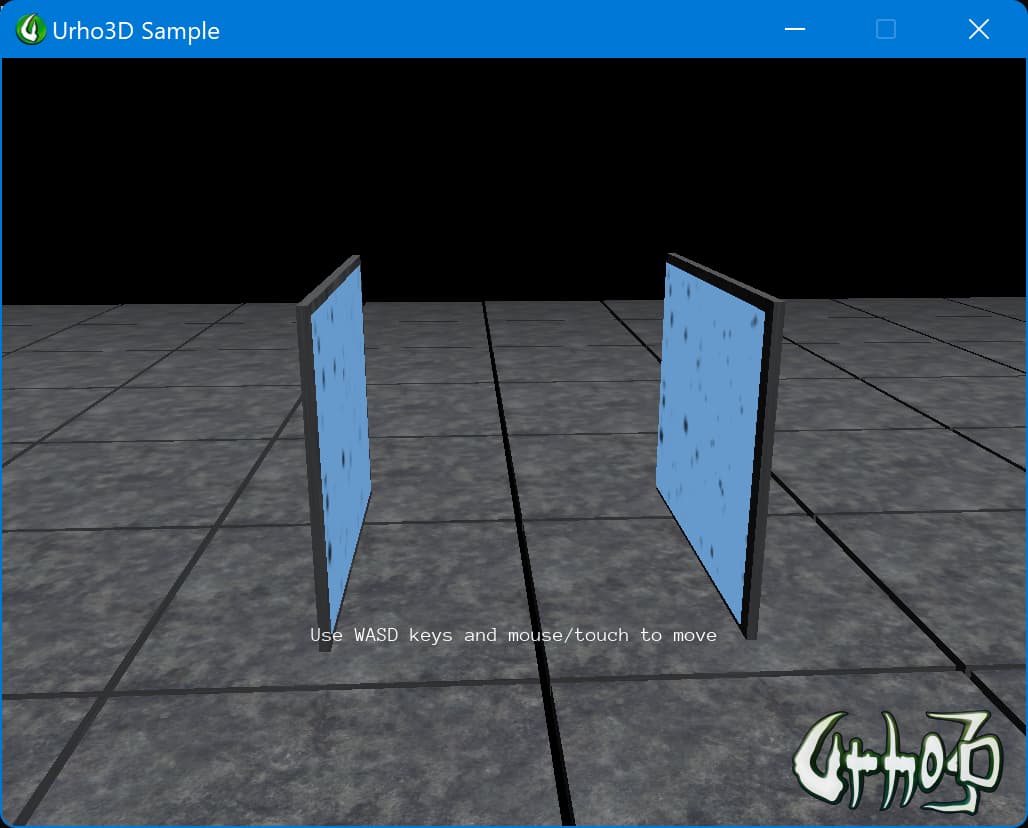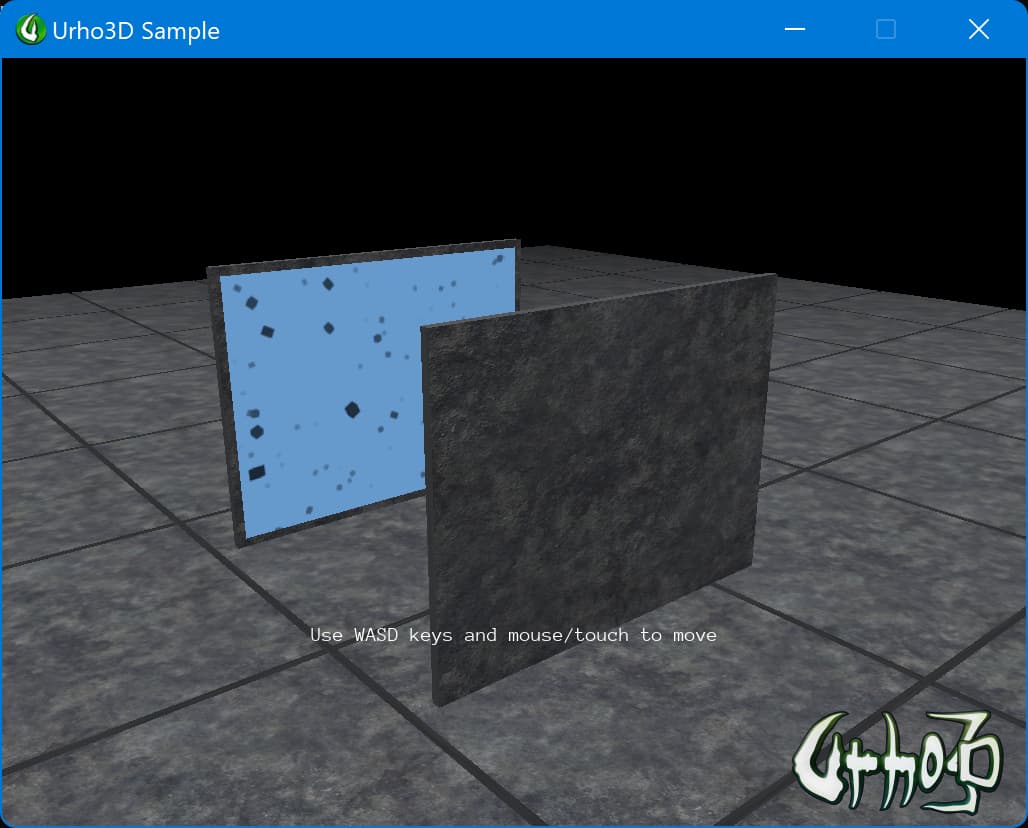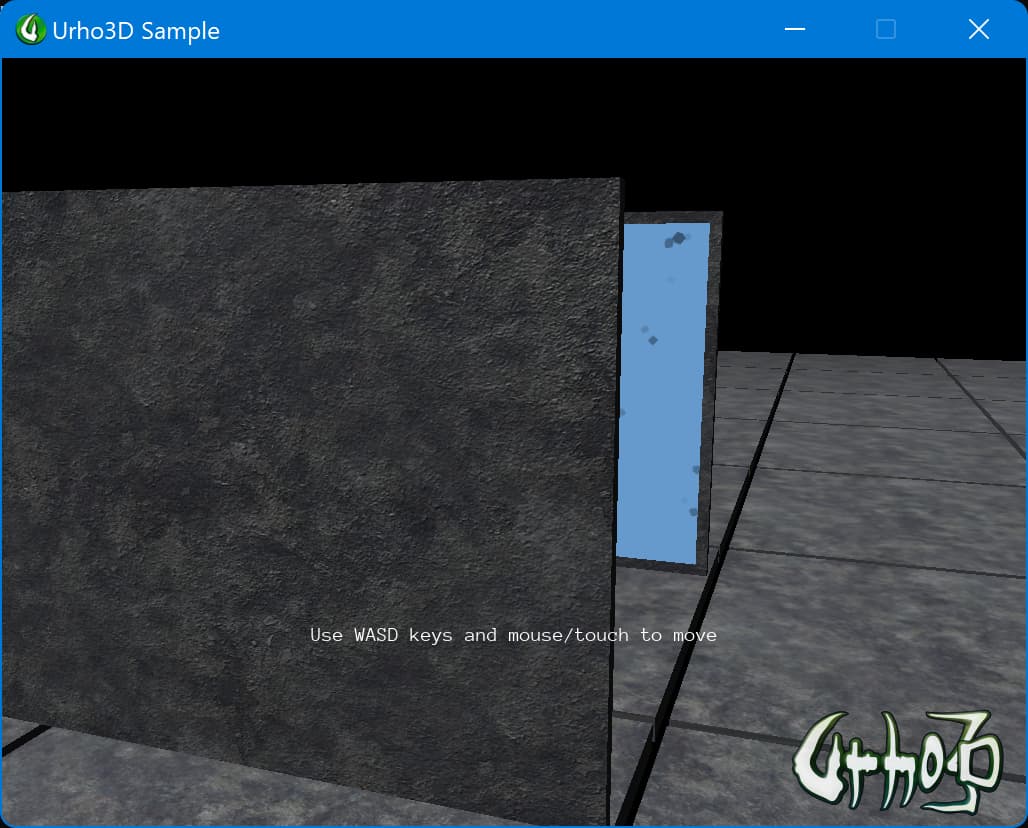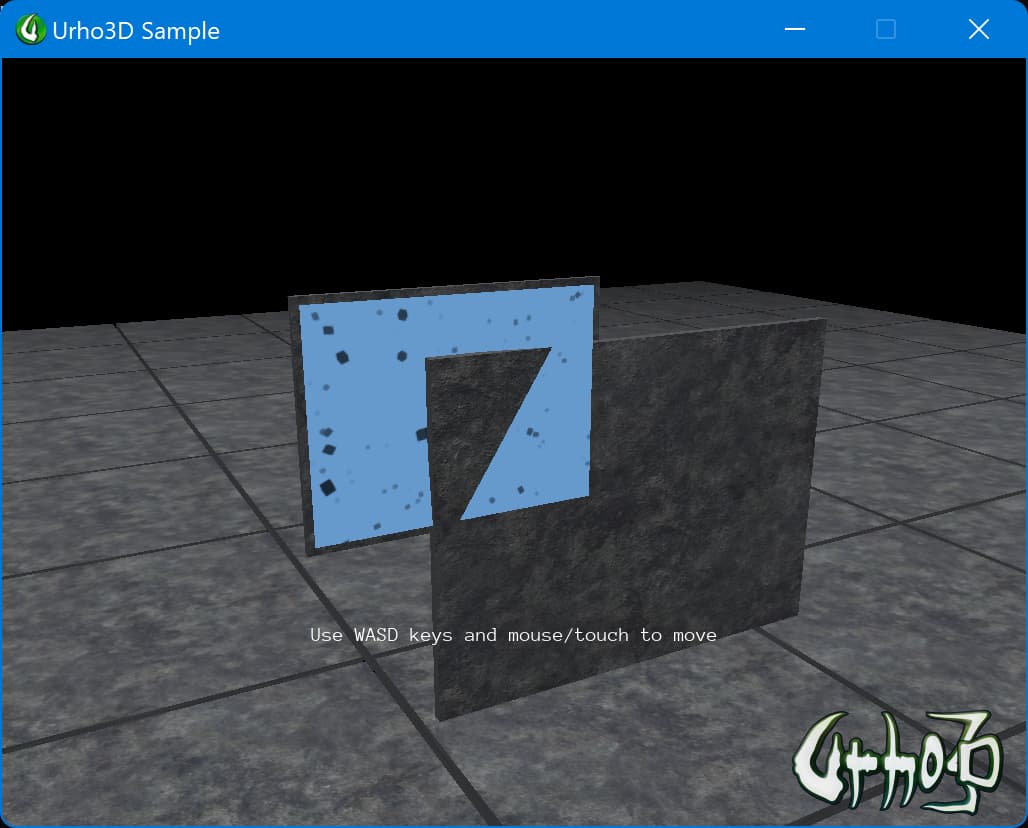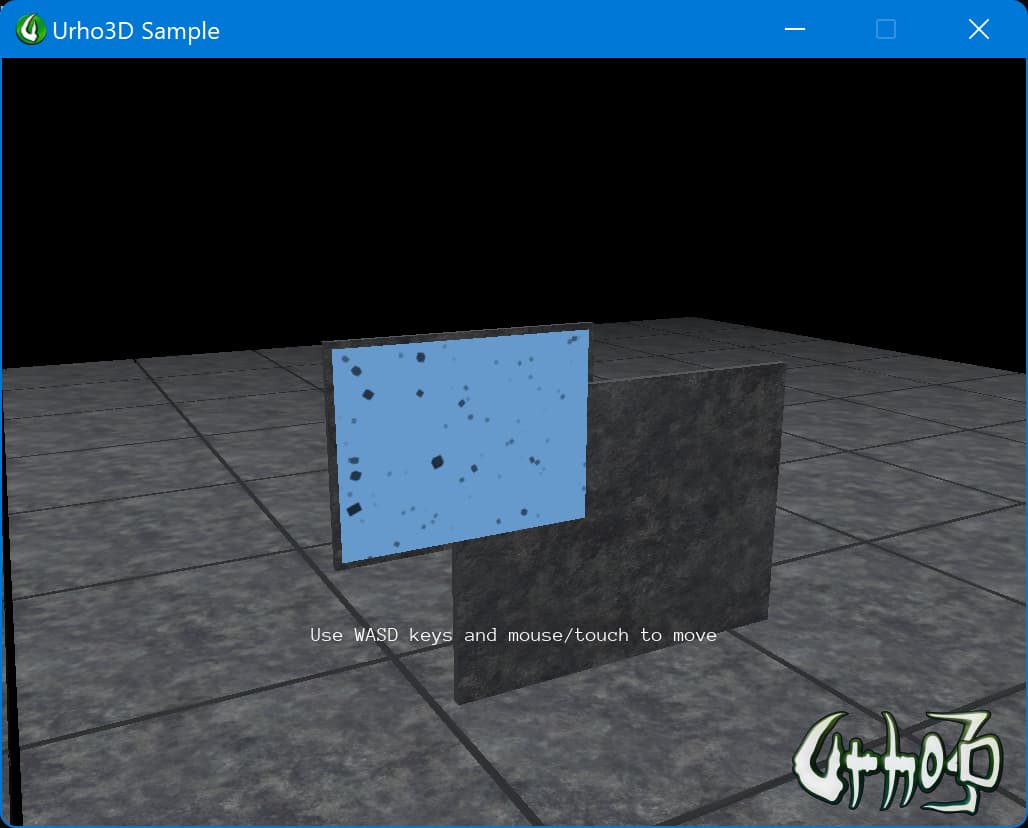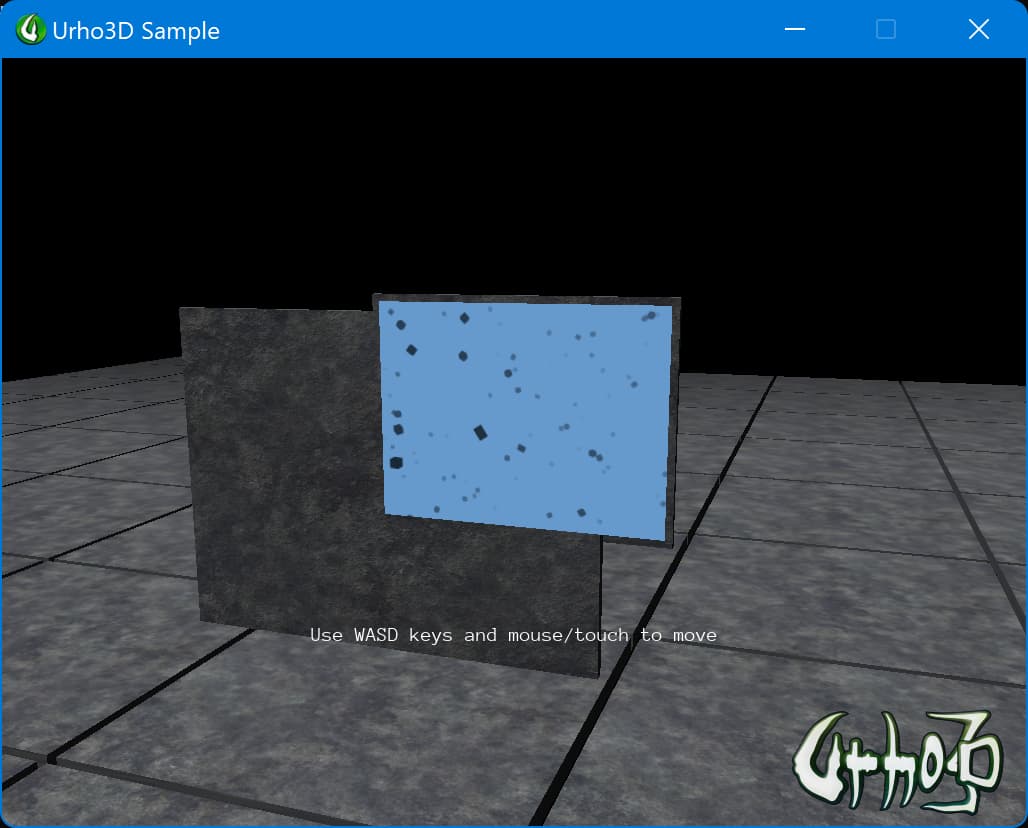Hello, everyone,
I follow the code of
Sample 10 RenderToTexture
to make a transformation.
Change one screen to two screens, and place the two screens face to face (Pic1).
When I (the camera) is close to the screens, everything is normal, and the screen at a distance can block the screen at a distance (as shown in Pic2, Pic3).
When I (the camera) is far away from the screens, then strange things happen, the screen in the distance will block the screen in the vicinity (Pic4, Pic5, Pic6).
I tried to modify various modes through
renderTexture->SetFilterMode
, but no effect;
I tried to set it to 0 and 1 through
screenTexture->SetNumLevels
, but it had no effect;
I tried to render a normal jpg image onto the texture, the same problem was also true.
Does anyone know how to solve this problem?
thanks.
Urho3d version: 1.7.1
test code below:
//
// Copyright (c) 2008-2017 the Urho3D project.
//
// Permission is hereby granted, free of charge, to any person obtaining a copy
// of this software and associated documentation files (the "Software"), to deal
// in the Software without restriction, including without limitation the rights
// to use, copy, modify, merge, publish, distribute, sublicense, and/or sell
// copies of the Software, and to permit persons to whom the Software is
// furnished to do so, subject to the following conditions:
//
// The above copyright notice and this permission notice shall be included in
// all copies or substantial portions of the Software.
//
// THE SOFTWARE IS PROVIDED "AS IS", WITHOUT WARRANTY OF ANY KIND, EXPRESS OR
// IMPLIED, INCLUDING BUT NOT LIMITED TO THE WARRANTIES OF MERCHANTABILITY,
// FITNESS FOR A PARTICULAR PURPOSE AND NONINFRINGEMENT. IN NO EVENT SHALL THE
// AUTHORS OR COPYRIGHT HOLDERS BE LIABLE FOR ANY CLAIM, DAMAGES OR OTHER
// LIABILITY, WHETHER IN AN ACTION OF CONTRACT, TORT OR OTHERWISE, ARISING FROM,
// OUT OF OR IN CONNECTION WITH THE SOFTWARE OR THE USE OR OTHER DEALINGS IN
// THE SOFTWARE.
//
#include <Urho3D/Core/CoreEvents.h>
#include <Urho3D/Engine/Engine.h>
#include <Urho3D/Graphics/Camera.h>
#include <Urho3D/Graphics/Graphics.h>
#include <Urho3D/Graphics/Material.h>
#include <Urho3D/Graphics/Model.h>
#include <Urho3D/Graphics/Octree.h>
#include <Urho3D/Graphics/Renderer.h>
#include <Urho3D/Graphics/RenderSurface.h>
#include <Urho3D/Graphics/StaticModel.h>
#include <Urho3D/Graphics/Technique.h>
#include <Urho3D/Graphics/Texture2D.h>
#include <Urho3D/Graphics/Zone.h>
#include <Urho3D/Input/Input.h>
#include <Urho3D/Resource/ResourceCache.h>
#include <Urho3D/Scene/Scene.h>
#include <Urho3D/UI/Font.h>
#include <Urho3D/UI/Text.h>
#include <Urho3D/UI/UI.h>
#include "RenderToTexture.h"
#include "Rotator.h"
#include <Urho3D/DebugNew.h>
URHO3D_DEFINE_APPLICATION_MAIN(RenderToTexture)
RenderToTexture::RenderToTexture(Context* context) :
Sample(context)
{
// Register an object factory for our custom Rotator component so that we can create them to scene nodes
context->RegisterFactory<Rotator>();
}
void RenderToTexture::Start()
{
// Execute base class startup
Sample::Start();
// Create the scene content
CreateScene();
// Create the UI content
CreateInstructions();
// Setup the viewport for displaying the scene
SetupViewport();
// Hook up to the frame update events
SubscribeToEvents();
// Set the mouse mode to use in the sample
Sample::InitMouseMode(MM_RELATIVE);
}
void RenderToTexture::CreateScene()
{
ResourceCache* cache = GetSubsystem<ResourceCache>();
{
// Create the scene which will be rendered to a texture
rttScene_ = new Scene(context_);
// Create octree, use default volume (-1000, -1000, -1000) to (1000, 1000, 1000)
rttScene_->CreateComponent<Octree>();
// Create a Zone for ambient light & fog control
Node* zoneNode = rttScene_->CreateChild("Zone");
Zone* zone = zoneNode->CreateComponent<Zone>();
// Set same volume as the Octree, set a close bluish fog and some ambient light
zone->SetBoundingBox(BoundingBox(-1000.0f, 1000.0f));
zone->SetAmbientColor(Color(0.05f, 0.1f, 0.15f));
//zone->SetFogColor(Color(0.1f, 0.2f, 0.3f));
zone->SetFogColor(Color(0.4f, 0.6f, 0.8f));
zone->SetFogStart(10.0f);
zone->SetFogEnd(100.0f);
// Create randomly positioned and oriented box StaticModels in the scene
const unsigned NUM_OBJECTS = 2000;
for (unsigned i = 0; i < NUM_OBJECTS; ++i)
{
Node* boxNode = rttScene_->CreateChild("Box");
boxNode->SetPosition(Vector3(Random(200.0f) - 100.0f, Random(200.0f) - 100.0f, Random(200.0f) - 100.0f));
// Orient using random pitch, yaw and roll Euler angles
boxNode->SetRotation(Quaternion(Random(360.0f), Random(360.0f), Random(360.0f)));
StaticModel* boxObject = boxNode->CreateComponent<StaticModel>();
boxObject->SetModel(cache->GetResource<Model>("Models/Box.mdl"));
boxObject->SetMaterial(cache->GetResource<Material>("Materials/Stone.xml"));
// Add our custom Rotator component which will rotate the scene node each frame, when the scene sends its update event.
// Simply set same rotation speed for all objects
Rotator* rotator = boxNode->CreateComponent<Rotator>();
rotator->SetRotationSpeed(Vector3(10.0f, 20.0f, 30.0f));
}
// Create a camera for the render-to-texture scene. Simply leave it at the world origin and let it observe the scene
rttCameraNode_ = rttScene_->CreateChild("Camera");
Camera* camera = rttCameraNode_->CreateComponent<Camera>();
camera->SetFarClip(100.0f);
// Create a point light to the camera scene node
Light* light = rttCameraNode_->CreateComponent<Light>();
light->SetLightType(LIGHT_POINT);
light->SetRange(30.0f);
}
{
// Create the scene in which we move around
scene_ = new Scene(context_);
// Create octree, use also default volume (-1000, -1000, -1000) to (1000, 1000, 1000)
scene_->CreateComponent<Octree>();
// Create a Zone component for ambient lighting & fog control
Node* zoneNode = scene_->CreateChild("Zone");
Zone* zone = zoneNode->CreateComponent<Zone>();
zone->SetBoundingBox(BoundingBox(-1000.0f, 1000.0f));
zone->SetAmbientColor(Color(0.1f, 0.1f, 0.1f));
zone->SetFogStart(100.0f);
zone->SetFogEnd(300.0f);
// Create a directional light without shadows
Node* lightNode = scene_->CreateChild("DirectionalLight");
lightNode->SetDirection(Vector3(0.5f, -1.0f, 0.5f));
Light* light = lightNode->CreateComponent<Light>();
light->SetLightType(LIGHT_DIRECTIONAL);
//light->SetColor(Color(0.2f, 0.2f, 0.2f));
light->SetColor(Color(0.8f, 0.8f, 0.8f));
light->SetSpecularIntensity(1.0f);
// Create a "floor" consisting of several tiles
for (int y = -5; y <= 5; ++y)
{
for (int x = -5; x <= 5; ++x)
{
Node* floorNode = scene_->CreateChild("FloorTile");
floorNode->SetPosition(Vector3(x * 20.5f, -0.5f, y * 20.5f));
floorNode->SetScale(Vector3(20.0f, 1.0f, 20.f));
StaticModel* floorObject = floorNode->CreateComponent<StaticModel>();
floorObject->SetModel(cache->GetResource<Model>("Models/Box.mdl"));
floorObject->SetMaterial(cache->GetResource<Material>("Materials/Stone.xml"));
}
}
// Create a "screen" like object for viewing the second scene. Construct it from two StaticModels, a box for the frame
// and a plane for the actual view
{
Node* boxNode = scene_->CreateChild("ScreenBox");
boxNode->SetPosition(Vector3(0.0f, 10.0f, 0.0f));
boxNode->SetScale(Vector3(21.0f, 16.0f, 0.5f));
StaticModel* boxObject = boxNode->CreateComponent<StaticModel>();
boxObject->SetModel(cache->GetResource<Model>("Models/Box.mdl"));
boxObject->SetMaterial(cache->GetResource<Material>("Materials/Stone.xml"));
//boxObject->GetMaterial()->GetTexture(TU_DIFFUSE)->SetNumLevels(4);
//boxObject->GetMaterial()->GetTexture(TU_DIFFUSE)->SetFilterMode(FILTER_DEFAULT);
Node* screenNode = scene_->CreateChild("Screen");
screenNode->SetPosition(Vector3(0.0f, 10.0f, -0.27f));
screenNode->SetRotation(Quaternion(-90.0f, 0.0f, 0.0f));
screenNode->SetScale(Vector3(20.0f, 0.0f, 15.0f));
StaticModel* screenObject = screenNode->CreateComponent<StaticModel>();
screenObject->SetModel(cache->GetResource<Model>("Models/Plane.mdl"));
// Create a renderable texture (1024x768, RGB format), enable bilinear filtering on it
SharedPtr<Texture2D> renderTexture(new Texture2D(context_));
renderTexture->SetSize(1024, 768, Graphics::GetRGBFormat(), TEXTURE_RENDERTARGET);
renderTexture->SetFilterMode(FILTER_BILINEAR);
//renderTexture->SetFilterMode(MAX_FILTERMODES);
//renderTexture->SetNumLevels(4);
// Create a new material from scratch, use the diffuse unlit technique, assign the render texture
// as its diffuse texture, then assign the material to the screen plane object
SharedPtr<Material> renderMaterial(new Material(context_));
renderMaterial->SetTechnique(0, cache->GetResource<Technique>("Techniques/DiffUnlit.xml"));
renderMaterial->SetTexture(TU_DIFFUSE, renderTexture);
// Since the screen material is on top of the box model and may Z-fight, use negative depth bias
// to push it forward (particularly necessary on mobiles with possibly less Z resolution)
renderMaterial->SetDepthBias(BiasParameters(-0.001f, 0.0f));
screenObject->SetMaterial(renderMaterial);
// Get the texture's RenderSurface object (exists when the texture has been created in rendertarget mode)
// and define the viewport for rendering the second scene, similarly as how backbuffer viewports are defined
// to the Renderer subsystem. By default the texture viewport will be updated when the texture is visible
// in the main view
RenderSurface* surface = renderTexture->GetRenderSurface();
SharedPtr<Viewport> rttViewport(new Viewport(context_, rttScene_, rttCameraNode_->GetComponent<Camera>()));
surface->SetViewport(0, rttViewport);
}
// +++++++++++++++++++ ADD SECOND SCREEN. ++++++++++++++++++++++
// Create a "screen" like object for viewing the second scene. Construct it from two StaticModels, a box for the frame
// and a plane for the actual view
{
Node* boxNode = scene_->CreateChild("ScreenBox");
boxNode->SetPosition(Vector3(0.0f, 10.0f, -20.0f));
boxNode->SetScale(Vector3(21.0f, 16.0f, 0.5f));
StaticModel* boxObject = boxNode->CreateComponent<StaticModel>();
boxObject->SetModel(cache->GetResource<Model>("Models/Box.mdl"));
boxObject->SetMaterial(cache->GetResource<Material>("Materials/Stone.xml"));
//boxObject->GetMaterial()->GetTexture(TU_DIFFUSE)->SetNumLevels(4);
//boxObject->GetMaterial()->GetTexture(TU_DIFFUSE)->SetFilterMode(FILTER_DEFAULT);
Node* screenNode = scene_->CreateChild("Screen");
screenNode->SetPosition(Vector3(0.0f, 10.0f, -19.57f));
screenNode->SetRotation(Quaternion(-90.0f, 0.0f, 180.0f));
screenNode->SetScale(Vector3(20.0f, 0.0f, 15.0f));
StaticModel* screenObject = screenNode->CreateComponent<StaticModel>();
screenObject->SetModel(cache->GetResource<Model>("Models/Plane.mdl"));
// Create a renderable texture (1024x768, RGB format), enable bilinear filtering on it
SharedPtr<Texture2D> renderTexture(new Texture2D(context_));
renderTexture->SetSize(1024, 768, Graphics::GetRGBFormat(), TEXTURE_RENDERTARGET);
renderTexture->SetFilterMode(FILTER_BILINEAR);
//renderTexture->SetFilterMode(MAX_FILTERMODES);
//renderTexture->SetNumLevels(4);
// Create a new material from scratch, use the diffuse unlit technique, assign the render texture
// as its diffuse texture, then assign the material to the screen plane object
SharedPtr<Material> renderMaterial(new Material(context_));
renderMaterial->SetTechnique(0, cache->GetResource<Technique>("Techniques/DiffUnlit.xml"));
renderMaterial->SetTexture(TU_DIFFUSE, renderTexture);
// Since the screen material is on top of the box model and may Z-fight, use negative depth bias
// to push it forward (particularly necessary on mobiles with possibly less Z resolution)
renderMaterial->SetDepthBias(BiasParameters(-0.001f, 0.0f));
screenObject->SetMaterial(renderMaterial);
// Get the texture's RenderSurface object (exists when the texture has been created in rendertarget mode)
// and define the viewport for rendering the second scene, similarly as how backbuffer viewports are defined
// to the Renderer subsystem. By default the texture viewport will be updated when the texture is visible
// in the main view
RenderSurface* surface = renderTexture->GetRenderSurface();
SharedPtr<Viewport> rttViewport(new Viewport(context_, rttScene_, rttCameraNode_->GetComponent<Camera>()));
surface->SetViewport(0, rttViewport);
}
// Create the camera which we will move around. Limit far clip distance to match the fog
cameraNode_ = scene_->CreateChild("Camera");
Camera* camera = cameraNode_->CreateComponent<Camera>();
camera->SetFarClip(300.0f);
// Set an initial position for the camera scene node above the plane
cameraNode_->SetPosition(Vector3(0.0f, 7.0f, -30.0f));
}
}
void RenderToTexture::CreateInstructions()
{
ResourceCache* cache = GetSubsystem<ResourceCache>();
UI* ui = GetSubsystem<UI>();
// Construct new Text object, set string to display and font to use
Text* instructionText = ui->GetRoot()->CreateChild<Text>();
instructionText->SetText("Use WASD keys and mouse/touch to move");
instructionText->SetFont(cache->GetResource<Font>("Fonts/Anonymous Pro.ttf"), 15);
// Position the text relative to the screen center
instructionText->SetHorizontalAlignment(HA_CENTER);
instructionText->SetVerticalAlignment(VA_CENTER);
instructionText->SetPosition(0, ui->GetRoot()->GetHeight() / 4);
}
void RenderToTexture::SetupViewport()
{
Renderer* renderer = GetSubsystem<Renderer>();
// Set up a viewport to the Renderer subsystem so that the 3D scene can be seen
SharedPtr<Viewport> viewport(new Viewport(context_, scene_, cameraNode_->GetComponent<Camera>()));
renderer->SetViewport(0, viewport);
}
void RenderToTexture::MoveCamera(float timeStep)
{
// Do not move if the UI has a focused element (the console)
if (GetSubsystem<UI>()->GetFocusElement())
return;
Input* input = GetSubsystem<Input>();
// Movement speed as world units per second
const float MOVE_SPEED = 20.0f;
// Mouse sensitivity as degrees per pixel
const float MOUSE_SENSITIVITY = 0.1f;
// Use this frame's mouse motion to adjust camera node yaw and pitch. Clamp the pitch between -90 and 90 degrees
IntVector2 mouseMove = input->GetMouseMove();
yaw_ += MOUSE_SENSITIVITY * mouseMove.x_;
pitch_ += MOUSE_SENSITIVITY * mouseMove.y_;
pitch_ = Clamp(pitch_, -90.0f, 90.0f);
// Construct new orientation for the camera scene node from yaw and pitch. Roll is fixed to zero
cameraNode_->SetRotation(Quaternion(pitch_, yaw_, 0.0f));
// Read WASD keys and move the camera scene node to the corresponding direction if they are pressed
if (input->GetKeyDown(KEY_W))
cameraNode_->Translate(Vector3::FORWARD * MOVE_SPEED * timeStep);
if (input->GetKeyDown(KEY_S))
cameraNode_->Translate(Vector3::BACK * MOVE_SPEED * timeStep);
if (input->GetKeyDown(KEY_A))
cameraNode_->Translate(Vector3::LEFT * MOVE_SPEED * timeStep);
if (input->GetKeyDown(KEY_D))
cameraNode_->Translate(Vector3::RIGHT * MOVE_SPEED * timeStep);
}
void RenderToTexture::SubscribeToEvents()
{
// Subscribe HandleUpdate() function for processing update events
SubscribeToEvent(E_UPDATE, URHO3D_HANDLER(RenderToTexture, HandleUpdate));
}
void RenderToTexture::HandleUpdate(StringHash eventType, VariantMap& eventData)
{
using namespace Update;
// Take the frame time step, which is stored as a float
float timeStep = eventData[P_TIMESTEP].GetFloat();
// Move the camera, scale movement with time step
MoveCamera(timeStep);
}

